Each game in the Yakuza franchise has a deep minigame that is easily exploitable for quick cash, and Yakuza: Like A Dragon is no exception. Mastering the game’s Ichiban Confections management mode can be tough given the game doesn’t really tell you everything you need to know about it. But once you do, you’ll be able to make 3 million yen in about four minutes.
Luckily, with our management seminar, you’ll have all the tools you need to bring Ichiban Confections to the top!
Management 101
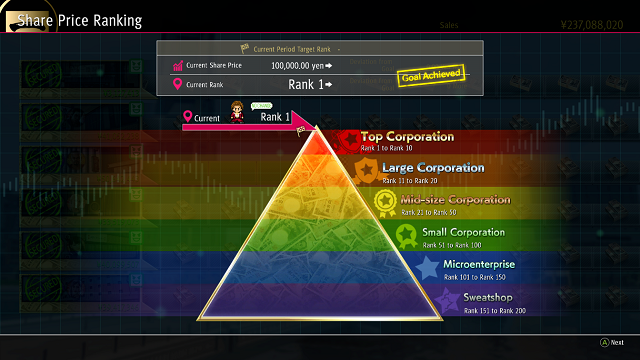
The goal of the management mode is for Ichiban to grow Ichiban Confections into Yokohama’s biggest business. You’ll do this by hiring the best employees, taking out loans to buy new properties, promoting workers, and hosting shareholder meetings.
Importantly, assets accrued in management mode cannot be used as in-game currency to buy gear. That said, as you climb the corporate ladder, Ichiban will get bonuses for successful shareholder meeting performances. These bonuses max out at 3 million yen per meeting, making the management mode an incredibly efficient way to farm yen.
Hiring Best Practices
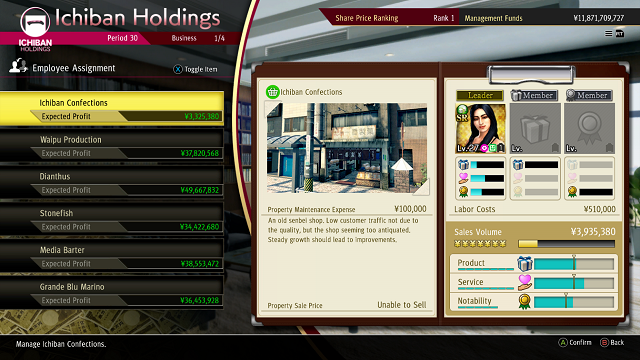
The key to any successful business is its employees. You’ll be able to hire a variety of workers in management mode, each with a different business specialty, and different statistics in the categories of Product, Service, and Notability.
In order to maximize profits, you’ll want to make sure you assign enough employees to each business you own so that each of those categories is fulfilled, allowing you to upgrade the business’s sales volume capacity. Keep those meters blue.
Importantly, only the manager can use all three of their statistics to satisfy those requirements. Each other worker slot will only be able to contribute to one statistic requirement, so make sure you assign workers accordingly.
If you assign a worker to a business they specialize in, you’ll also get a pretty significant stat boost as well.
Bonuses and Care
Don’t overwork your employees, or profits will suffer. Having highly motivated employees means you’re more likely to have positive, profit-boosting events happen during the actual work simulation. After each day of business, make sure to perform auto-care on your employees. It can be expensive, but it’s worth it.
Promotions and Training
All of your workers will start off with a level cap that can be raised by promoting them. However, this will also increase their salary, so be careful!
Once you’ve promoted them, also consider training them for massive EXP boosts (especially if there’s a guest lecturer event happening, you can double your growth occasionally!)
The level max is 30, but we suggest you reserve this for SSR-UR workers, as they have the most growth potential, and promoting too many workers can hurt your bottom line.
It’s much more cost-effective to have highly specialized workers that don’t need to be promoted and leveled up to hit targets rather than training up employees that aren’t quite suited for the properties you currently own.
Properties
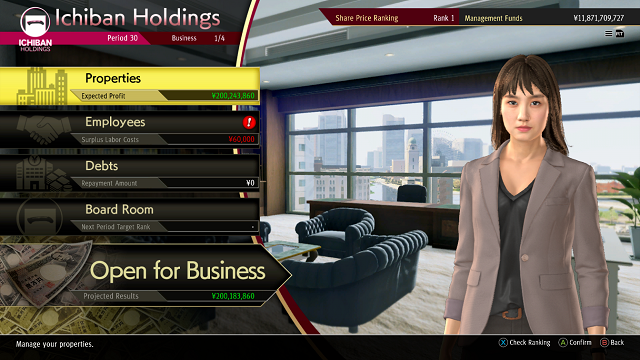
As you progress in management mode, you’ll be able to buy (and sell) properties to maximize your profits.
The rule of thumb when looking at a potential property is to look at both the sales volume potential (shown in yen symbols) and the current expected profit.
The sales volume potential shows how many times you’ll be able to upgrade the property’s sales volume, which is more important in the long run than a high current expected profit.
Upgrading Properties
Though this may seem daunting, as long as you have all of a property’s requirement bars in the blue (and enough cash to do so), you should be able to upgrade sales volume once, then upgrade product, service, and notability while still being in the blue.
Prioritize high earners for best results.
Loans and Special Events
We recommend only taking out loans to help pay for new, high-earning properties, and only doing so through banks to minimize interest payments. It’ll cut into your profits in the short run, but if you’ve optimized your properties correctly, you’ll be able to cover your loan payments and still have more than enough cash on hand to pay staff and make upgrades.
Occasionally, you’ll also be presented with special events that require your input as an owner.
Hiring Agency
Sometimes, you’ll get the chance to hire a worker directly at an odd rate (usually a high down payment but a low salary). These workers can often be rarer than the ones you’ll find in the normal recruitment section, so be aware and make sure you have enough money on hand to hire if this comes up!
Commercials
This is probably the most important tip we can give. Early on, always try to have at least 5 million yen on hand in order to pay for a commercial. Later, after the company becomes Ichiban Holdings, you’ll want to save 10 million. They’re expensive, but commercials can double, if not triple, your daily profits. They’ll pay for themselves in no time flat.
Investment Opportunities
These are iffy. We’ve found no correlation between what Ichiban says in regards to the investments and how they actually perform. We recommend just ignoring them, as it’s easier, quicker, and more reliable to make money the old-fashioned way.
Shareholder Meetings
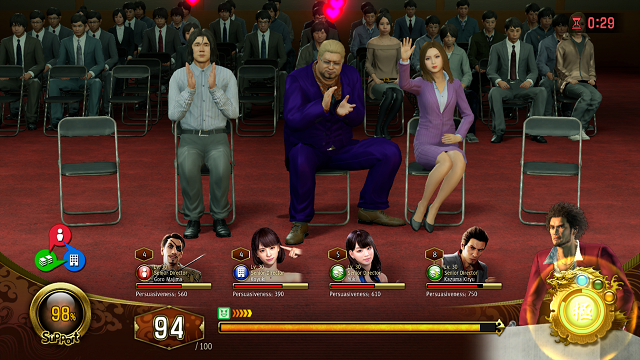
Shareholder meetings are absolutely key for growing your business, and successful ones not only skyrocket you through the business rankings but also give you some take-home money to boot.
Preparing
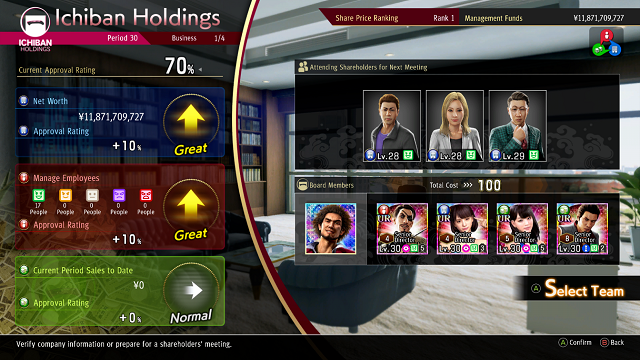
The first thing you’ll want to do when preparing for your meetings is to check your three key statistics:
- Net worth (how much cash you have on hand right now)
- Employee morale (how happy your employees are. If this isn’t Great, you should perform auto-care.),
- Current period sales (how much money you’ve made since the last meeting). This will determine how difficult the meeting will be, and how long it’ll take to defeat your shareholders in debate.
The other thing to take into account is shareholder types. Each has one of three types: Employee, Financial, or Property. This determines who you’ll want squaring off against them.
Employee-based workers are effective against financial-based shareholders, financial-based workers are effective against property-based shareholders, and property-based shareholders are effective against employee-based shareholders.
It’s like rock-paper scissors, and that weakness order is always displayed in a triangle on-screen if you ever forget.
Begin the Meeting!
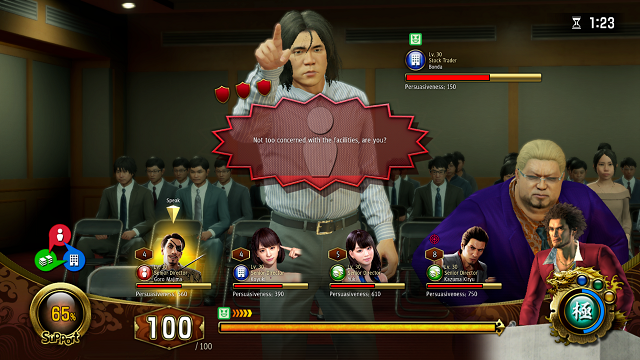
As the meeting begins, you’ll have multiple shareholders to select from. It’s your job to refute all their arguments with your workers.
Your workers each have different levels of worker confidence and persistence (read: attack and HP) as well as a skill cost you’ll have to pay in order to call them in.
Once you pick a shareholder, they’ll put forth their argument. Keep in mind that, as in this example, this argument may not be the same type as their own personal type.
Notice how the shareholder is an employee-type, but his argument is a property type. Scroll through your workers to find one who is strong against the argument (a ‘WEAK” pop-up will appear) and smash through it.
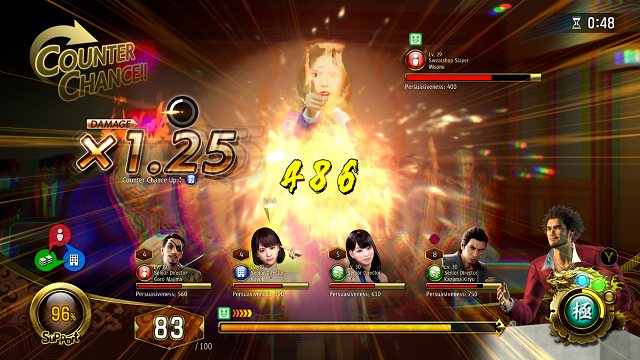
Now it’s time to do some damage. Look to the left, and you’ll see a “Counter Chance” icon. This shows the type a shareholder is weak to. Again, this may not necessarily be the same type their opening argument was weak to! In this case, it’s the property type, so we’ll go with Koyuki.
Pick a worker of that type and attack. As you do, a multiplier will go up, allowing you to do more damage in succession.
Repeat this process for all remaining shareholders, keeping in mind that if you get into trouble and are low on energy to call your workers, you can always use the apologize button to do damage and buy a little bit of time.
By the end, you should be able to pacify them all relatively easily! Even when bosses appear, these same strategies hold true. None of them throw you any major curves.
That’s it! You now know everything you need to know to hire the best employees, bring Ichiban Confections to the top, and make Nick Ogata proud. After you complete the management minigame, your bond with Eri will be maxed, she’ll learn a new attack, and you’ll be able to return to management anytime to farm yen!

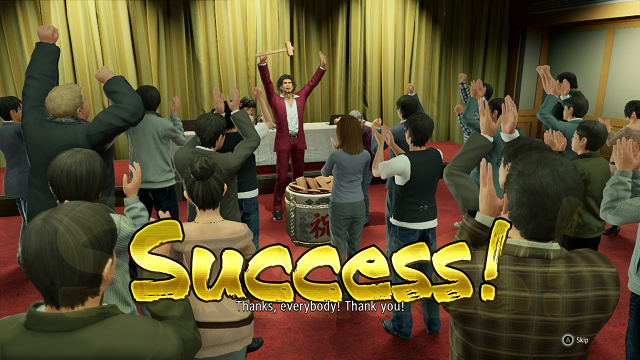





Published: Nov 20, 2020 05:44 pm